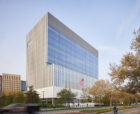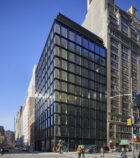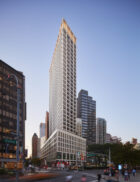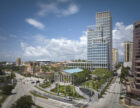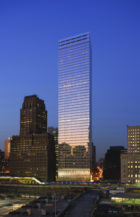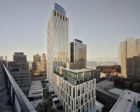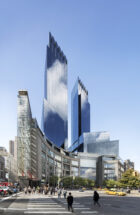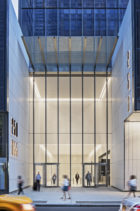“Radical reduction”—which marries sustainability and minimalist intentionality—is the design philosophy that guides Chris Cooper’s work. Whether designing a light fixture or an urban master plan, Chris prioritizes the efficient use of resources to create an architecture of purity and strength, focused foremost on the human experience. The result is a portfolio of rigorous, purposeful, and elegant projects that range from workplace interiors to residential, commercial, and cultural landmarks.
7 World Trade Center, one of Chris’s early works, was the first tower to be rebuilt on the World Trade Center site and established a vision for the future of the district, while setting a benchmark for environmental performance. The building reads almost as a piece of industrial design with its finely calibrated glass facade, created in collaboration with artists and material specialists. More recently, the design for 175 Park Avenue, a prominent new tower, takes on a civic dimension as it enhances the public realm around Grand Central Terminal. Nearby in East Midtown, Chris’s design for the Permanent Mission of the United Arab Emirates to the United Nations blends arabesque design elements with New York architectural influences to create a sophisticated and inspiring environment inside and out.
Chris’s work extends to the sensitive renovation and transformation of historic buildings. At 500 Park Avenue, a landmark modernist building designed by SOM in 1960, Chris led a major interior renovation to create a contemporary office space that echoes the timeless quality of the original design.
We approach each project with a focus on the smart allocation of resources for maximum human, and minimum environmental impact. At every scale, we innovate with intelligence, rigor, and intention.
As the founding partner of SOM’s Climate Action Group, Chris works to elevate standards for sustainable design—from 7 World Trade Center, which was the first commercial office building to achieve LEED-C/S Gold certification; to the redevelopment of the U.S. Department of Transportation’s Volpe Center in Cambridge, designed to achieve net zero carbon; to a new, secure, and sustainable production facility for the U.S. Department of the Treasury’s Bureau of Engraving and Printing.
Chris serves on the board of the SOM Foundation, whose goal is to support research and ideas that advance the spirit of innovation in architecture, design, and engineering.


